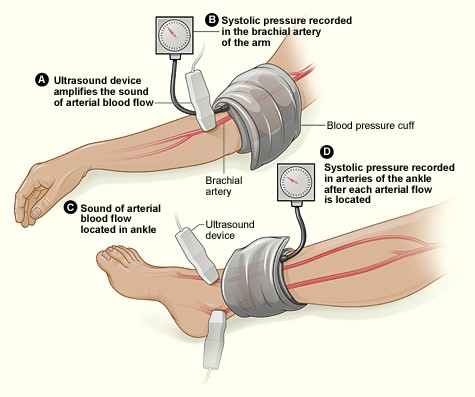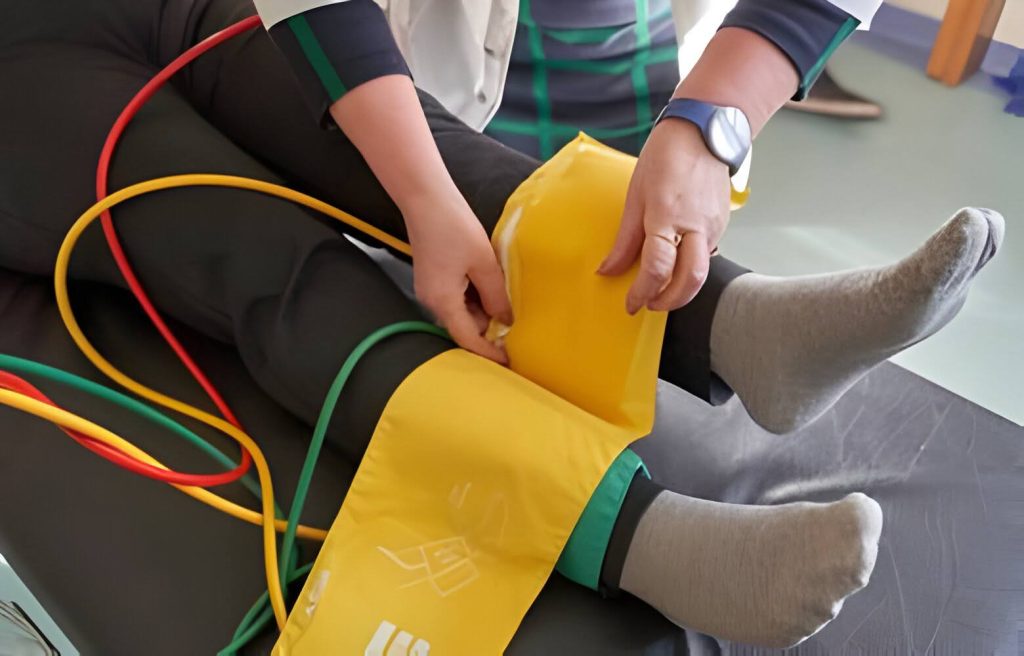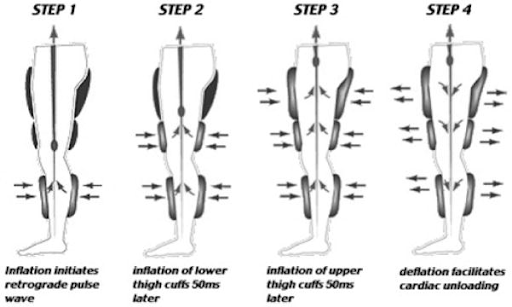

ABI stands for Ankle-Brachial Index, which is a non-invasive diagnostic test used to assess peripheral arterial disease (PAD) in the lower extremities. It compares the blood pressure in the ankles to the blood pressure in the arms to evaluate the presence and severity of arterial blockages or narrowing in the legs.
Procedure
During an ABI test, the following steps are typically performed:- Preparation: The patient lies comfortably on an examination table in a supine position.
- Blood Pressure Measurement: A blood pressure cuff is placed around the upper arm (brachial artery) and inflated to measure the systolic blood pressure using a Doppler ultrasound probe.
- Ankle Pressure Measurement: Blood pressure cuffs are placed around the ankles, one at the dorsalis pedis artery (on the top of the foot) and the other at the posterior tibial artery (behind the ankle). The cuffs are inflated to measure the systolic blood pressure at each ankle using the Doppler ultrasound probe.
- Calculation of ABI: The ankle systolic blood pressure is divided by the brachial systolic blood pressure to calculate the ankle-brachial index for each leg. The ABI is expressed as a ratio (e.g., ankle systolic pressure / brachial systolic pressure).
- Interpretation: The ABI values are interpreted to assess the presence and severity of peripheral arterial disease (PAD). An ABI of 0.90 or higher is considered normal, while values less than 0.90 indicate PAD, with lower values corresponding to more severe disease.
Indications
ABI testing may be indicated for patients presenting with symptoms suggestive of peripheral arterial disease (PAD), including:- Claudication (cramping or pain in the legs with activity)
- Rest pain or ischemic ulcers in the legs or feet
- Absent or diminished pulses in the lower extremities
- Non-healing wounds or ulcers on the legs or feet
- Coldness or discoloration of the legs or feet
- History of smoking, diabetes, hypertension, or other cardiovascular risk factors
Benefits
ABI testing offers several benefits for patients suspected of having peripheral arterial disease (PAD), including:- Non-invasive: The test is non-invasive and does not involve the use of ionizing radiation or contrast agents, making it safe and well-tolerated by most patients.
- Quick and simple: ABI testing is a quick and simple procedure that can be performed in the outpatient setting without the need for anesthesia or sedation.
- High sensitivity: ABI has high sensitivity for detecting peripheral arterial disease (PAD), allowing for early diagnosis and intervention to reduce the risk of complications such as limb ischemia or amputation.
- Prognostic information: ABI values provide prognostic information about the severity of PAD and the risk of cardiovascular events such as heart attack or stroke, helping guide treatment decisions and management strategies.
Limitations
While ABI testing is a valuable diagnostic tool for evaluating peripheral arterial disease (PAD), it has some limitations, including:- False positives: ABI may be falsely elevated in patients with calcified or non-compressible arteries, leading to overestimation of the ankle pressures and underdiagnosis of PAD.
- False negatives: ABI may be falsely normal in patients with mild or early-stage PAD, particularly if collateral circulation is present, leading to underestimation of the disease severity.
- Operator dependence: The quality and accuracy of ABI measurements depend on the skill and experience of the healthcare provider performing the test and the proper selection of cuff sizes and placement techniques.




